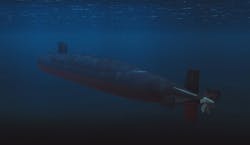Lockheed Martin to upgrade ballistic missile submarine inertial navigation with new laser gyro technology
WASHINGTON – U.S. Navy navigation and guidance experts are asking Lockheed Martin Corp. to build precise inertial navigation systems for U.S. Navy Ohio- and future Columbia-class ballistic missile submarines under terms of a $191.2 million contract announced last week.
Officials of the Strategic Systems Programs office in Washington are asking the Lockheed Martin Rotary and Mission Systems segment in Uniondale, N.Y., to build Trident SSI Increment 8 inertial navigation systems and inertial spare parts for the Ohio and Columbia ballistic missile submarine shallow water submersible platforms for the fleet ballistic missile program.
For more than 20 years the U.S. Ohio-class ballistic missile submarines have used the Electrostatically Supported Gyro Navigator (ESGN) as the vessel's inertial navigation system. The ESGN uses a precise laser gyro for precision undersea navigation and positioning that operations independently of GPS or celestial navigation.
An inertial navigation system uses a computer, motion sensors, accelerometers and gyroscopes to calculate continuously by dead reckoning the position, the direction and speed of movement of a moving object without the need for external references. Precise inertial navigation for submarines typically uses ring laser gyros or laser-based fiber-optic gyros.The SSI Increment 8 program seeks to replace the 30 year old ESGN which needs a refresh of inertial technology components. This program also seeks to replace the Ohio-class submarine's electronic equipment consoles and update navigation subsystem software.
The Ohio-class submarine's ESGN is from the Boeing Co. Defense, Space & Security segment in Huntington Beach, Calif. The ESGN originally was designed by the former Rockwell Autonetics business unit in Anaheim, Calif., which Boeing acquired in 1996.
The ESGN enables ballistic missile submarines to navigate precisely underwater for long distances and long durations, and is accurate enough to launch intercontinental missiles with pinpoint accuracy. The new submarine inertial navigation system is expected to be even better.
It was Rockwell Autonetics that designed the inertial navigation system that enabled the U.S. Navy's first operational nuclear-powered submarine USS Nautilus to navigate safely while traversing underneath Earth's polar ice cap in 1958.
On this contract Lockheed Martin and company partners will do the work in Heath, Ohio; Huntington Beach, Calif.; Uniondale, N.Y.; and Manassas, Va., and should be finished by February 2028.
For more information contact Lockheed Martin Rotary and Mission Systems online at www.lockheedmartin.com, Boeing Defense, Space & Security at www.boeing.com/company/about-bds, or the Strategic Systems Programs office at www.ssp.navy.mil.

